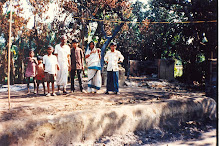October 16, 1905: A Forgotten Date of Indian/Bengali History [1]
Sachi G. Dastidar
October 16 is a very important date in the Indian calendar but very few people in the Subcontinent — India, Bangladesh or Pakistan — will remember this day as mythology- and ancient tradition-influenced Hindu culture is not readily influenced by date-specific historic events. On that day one hundred years ago in 1905 the Colonial British Administration mandated a Muslim-Hindu (non-Muslim) partition of mixed, tolerant Bengal Province in eastern India when there was no such demand from either community. In Indian history this date is possibly more profound than 9/11 for America, but very few in the Subcontinent talk about that. This is may also be the beginning of the modern Islamist movement of the world. In the late 1800s and early 1900s Calcutta, the British Colonial capital, and Bengal of which Calcutta was also the capital, was leading an intense struggle for Indian independence joined by India’s diverse religious and linguistic groups — Hindu, Muslim, Buddhist, Christian, Brahmo. Bengal was then evenly divided between Muslim and non-Muslim. Colonial ruler Lord Curzon devised a divide-and-rule policy to create a cleavage among Indians, starting with the Bengalis first. He proposed the creation of a majority-Muslim East Bengal Province with extra privileges for ‘backward Muslims,’ and a Hindu-majority (West) Bengal. The British Raj sanctioned huge sums of money to a non-native Urdu-speaking Muslim landlord, Nawab Salimullah, of Dhaka of East Bengal, now Bangladesh, to promote an anti-independence Muslim League Party to counter the more numerous Hindus and other non-Muslims in the independence struggle. After an intense effort by mostly-non-Muslim Indians of the entire Subcontinent the province was reunited in 1912 but that communal impetus gave rise to intolerant, separatist Islamism. Muslim-non-Muslim killings became ‘a part of life’ in Bengal and Indian Subcontinent. Success of the first ever use of divide-and-rule policy would make Britain use that tool later in Ireland, Cyprus, Africa, Asia and the Caribbean. Other European colonial powers would use similar policies elsewhere. The Islamism that the British Raj nurtured in Indian soil eventually partitioned Bengal in 1947, almost along the same geographical line that Curzon devised in 1905, along with partitioning of India, Punjab, Assam and Kashmir and creation of Islamic Pakistan and Bangladesh. One could easily argue that this was the beginning of the making of the minds of extremism. Ironically for the creation of these Islamic states another October 16 in 1946, is intimately associated with. To galvanize public opinion for Muslim-non-Muslim partition of India a ghastly anti-Hindu pogrom was initiated on a Hindu holy day in its remote eastern Noakhali district when Bengal’s Muslim League Premier Surahwardy was in charge of the province. British Army and Police watched as thousands of Hindus were killed and tens of thousands of girls and wives were converted which is known as Noakhali Danga pogrom. Gandhiji went to Noakhali to stop that carnage. This killing followed the August 16 Hindu-Muslim killing also in 1946, known as Great Calcutta Killing, as the British Police, Premier Surahwardy and Calcutta Mayor Osman (Usman) remained in the sidelines. Yet in the typical Indian, Bengali or Hindu psyche there in neither any memorial to those carnages nor to the millions of people killed in the 1947 pre- and post-partition-related violence. Today in Bengal there won’t be any commemoration for that British-invented event that has had untold human sufferings and enormous geo-political impact as Bangladesh is run by a coalition of pro-Islam, pro-Taliban parties and West Bengal by hard-line communists. Since the second British partition of Bengal in 1947 Bangladeshi Hindus have come down from a third of the population to below 10% now, a loss of over 48 million people from Bangladeshi Census! Minority Muslim populations in both Hindu-majority West Bengal and India have risen since 1947; yet feels vulnerable by that partition. On this important day let us take a moment to pray for the innocent victims of that Colonial 9/11. Let us hope that such divisiveness would never be used for national governance.
[1] From a Calcutta, India newspaper
Sunday, February 8, 2009
October 16, 1905: A Forgotten Date of Indian/Bengali History
Labels:
1905,
2005,
Bengal Partition,
Hindu Muslim Separation,
Indian Partition
Subscribe to:
Post Comments (Atom)

No comments:
Post a Comment